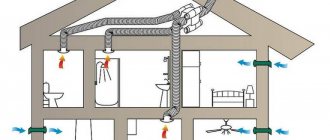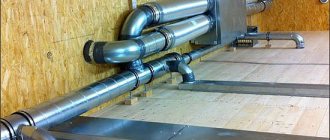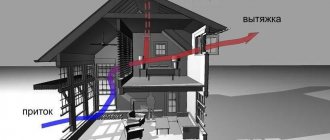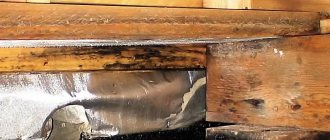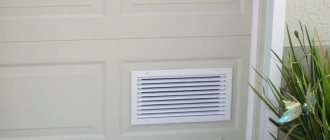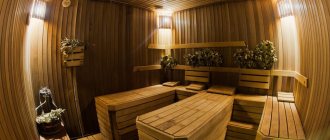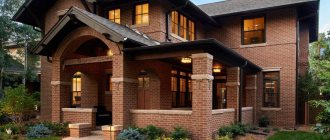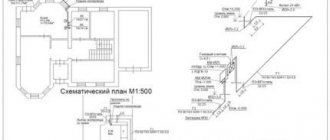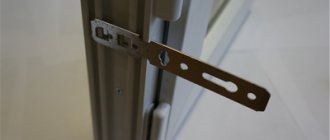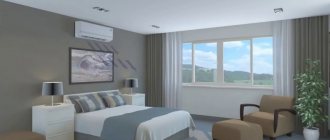Duct types
The ventilation system is an important element of any home, apartment or enterprise, which ensures the removal of unpleasant odors from the premises, reduction of humidity, and the flow of clean air from the external environment. All rooms of the house need ventilation, especially the bathroom, where there is always high humidity, as well as the kitchen, where there is a lot of steam, fat fumes, and the smell of cooking food in the air. If a gas boiler is used in the house, then the installation of an air duct is also mandatory for fire safety reasons.
The main element of ventilation is the air duct, the quality, design and size of which directly determine the functioning of ventilation systems. A number of requirements are put forward to it:
— ensure high tightness;
— meet standards for aerodynamic noise levels;
— guarantee the necessary air capacity;
— restrain the calculated pressure of the air mass;
— provide the required thermal insulation.
Another criterion that ventilation ducts must meet is their compact size. It is important that the air ducts do not reduce the usable area of the premises.
WHAT DOES THE DUCT LOOK LIKE?
Externally, the ventilation duct looks like a pipeline through which air moves. An air duct system can usually be formed by both straight pipes and elements of various shapes that determine the desired direction of air flow, as well as the combination or separation of air mass flows. The appearance of the air duct depends on many different factors, such as the material from which it is made, cross-sectional shape, size, purpose, scope of application, and so on. Let's look at the classification in more detail.
Winter veranda: equipment and arrangement
Not long ago we were talking about how to insulate a gazebo and prepare it for winter.
But this is not the only option, because at the dacha you can also convert the veranda. And so, today on the agenda is a winter veranda, its equipment and maximum increase in comfort. Not everyone at their dacha has a gazebo, or, in principle, a veranda, but since we talked about a winter gazebo, which you can move into during cold weather, we think that you should think about a veranda. We will not describe again the process of constructing a veranda, about which there is already an article on the DachaDecor.ru website, and we will not talk about insulation. And we will spend time describing how to put the veranda in order and make it truly winter. After all, this is where you can now drink morning tea, have lunch during the day, talk before bed, or even get together on the weekend over barbecue and strong drinks. So, a turnkey winter veranda, or the most comfortable configuration of this room, which, after our recommendations, you can completely transform.
AIR DUCTS MATERIALS
If previously only plastic was used for the production of elements of ventilation systems, now the choice is much wider. Air ducts can be made of plastic, metal-plastic, and also textile material. Let's look at the advantages and disadvantages of each of these materials.
PLASTIC
Inexpensive air ducts for private construction are made from plastic.
The products are quite durable, have high rigidity, and can be used for many years without deterioration in their characteristics. They are made from different types of plastic: - polyvinyl chloride - an inexpensive material, resistant to ultraviolet radiation, does not deform in a wide temperature range - from 0°C to +80°C;
— polypropylene – the material can withstand heating up to +100°C, but at low temperatures it becomes brittle;
— fluoroplastic – products and materials are resistant to vapors with acids and alkalis, does not deform or collapse at ambient temperatures from -40°C to +140°C;
— polyethylene – air ducts made of this material are characterized by antistatic protection and can be used at temperatures from -40°C to +80°C; If black carbon is added to polyethylene, the material becomes resistant to ultraviolet radiation.
ADVANTAGES OF PLASTIC AIR DUCTS
The advantages of plastic air ducts are as follows:
— 100% moisture resistance;
— long service life;
- low price;
— ease of maintenance and cleaning of air ducts;
— the smooth internal surface does not reduce air speed and air duct capacity;
— ease of installation;
- environmental friendliness of the material.
DISADVANTAGES OF PLASTIC AIR DUCTS
- low fire resistance;
— not suitable for industrial ventilation.
METAL
Metal is a traditional material for the manufacture of air ducts for ventilation systems, both industrial and residential. Most often, steel (black, galvanized, stainless) is used for production.
— black steel is used for the manufacture of air ducts for industrial purposes - this material is highly fire resistant, it is durable, and guarantees high structural rigidity; the tightness of such a pipeline is ensured by welds;
— stainless steel – this material is used in cases where the appearance of aggressive substances (acid, alkali) and increased humidity are possible in the environment; In addition, stainless steel is durable and resistant to temperature changes;
- galvanized steel - products made from this metal can be used in any climatic zone, the surface of the pipelines is reliably protected from corrosion by a layer of zinc.
ADVANTAGES OF METAL AIR DUCTS
The advantages of metal air ducts are as follows:
— high mechanical strength;
— durability;
— resistance to ultraviolet radiation, temperature changes;
— high fire safety;
- can be used at home and at work.
DISADVANTAGES OF METAL AIR DUCTS
- high price;
— heavy weight of the elements, which requires additional fastenings when installing the air duct;
— increased noise during operation of the air duct.
METAL-PLASTIC
Metal-plastic air ducts have a sandwich structure, which consists of two layers of metal and one layer of plastic. Often the metal layer is made from corrugated aluminum. It provides products with good rigidity, low weight and durability.
ADVANTAGES OF METAL-PLASTIC AIR DUCTS
The advantages of air ducts in this category are as follows:
— air flows well through the metal-plastic channel;
— low noise level during ventilation operation;
— ease of installation and maintenance;
- light weight;
— environmentally friendly materials are used.
DISADVANTAGES OF METAL-PLASTIC AIR DUCTS
A significant disadvantage of such air ducts is their high cost.
Natural or forced – which is better?
Based on the method of stimulating air, ventilation is divided into natural, which occurs without the intervention of the owners of the house, and artificial or forced, organized with the help of fans and air ducts.
The simplest example of natural ventilation is an apartment in a house with wooden windows. Although the hood is organized during construction, it obeys the laws of physics, and air enters through cracks in window and door openings, open windows and vents.
In village houses, which many use as seasonal housing, air circulation is also carried out using a brick stove with a chimney and pipe
But sometimes natural air exchange is not enough to create a healthy, comfortable living environment. And then you have to use the devices listed above and install new ventilation ducts.
Either plastic pipes or galvanized elements are used as air ducts. They are located above suspended structures and in walls with access to the outside above the roof or in the wall.
To create complete ventilation, entire systems of insulated, sealed ducts passing through all rooms are constructed. But this option is suitable for permanent residences, as it requires a more serious approach.
The best way to establish proper ventilation is a combination of natural and mechanical methods to improve air circulation. From this side, a country house is no different from an ordinary city apartment: in addition to the half-open window, you can add the installation of a fan in the toilet and the installation of an inexpensive hood in the kitchen.
VENTILATION FROM TEXTILE DUCT
Textile air ducts are a new type of air ducts used to create ventilation systems for premises for various purposes. These products provide optimal air distribution; they are actively used to create supply and exhaust ventilation, climate control and air conditioning systems.
Air ducts can be of several types; they differ in the material used and performance characteristics.
- Air-permeable - they are made of polyamide, they are intended for transportation and uniform distribution of air masses throughout the premises. They are also called fabric diffusers. The breathable material serves both as a channel for transporting air and for filtering it from mechanical contaminants.
- With myco-perforation - the presence of micro-holes in the fabric allows you to evenly distribute air in the room at a low speed of its movement along the air duct. Thanks to this method of supplying and distributing air, such air ducts are used in places where many people often gather.
- “Textile nozzle” - this type of air duct is used to provide targeted air supply to a specific area of the workspace. They are also installed to create an air curtain.
There is another type of textile diffuser made using membrane technology. An airtight membrane is installed in the fabric air duct along its entire length, the position of which is controlled by a servo drive. The direction of air movement and the ability to disperse it depend on the position of the membrane. In this way, you can regulate the movement and distribution of air flows directed to different rooms.
In hot air transportation systems, as well as in rooms with increased fire hazard, air ducts made of material that includes fiberglass are used. Air heated to +300°C can be transmitted through such channels.
MAIN CHARACTERISTICS OF TEXTILE MATERIAL
— high strength;
— resistance to ignition and combustion (flammability class G1, flammability class B1);
— can be installed in “clean rooms” (up to class 4);
— antistatic and antibacterial effect;
— ease of maintenance;
— the color of the fabric does not fade over many years.
Air exchange in residential premises
The recommended amount of air exchange is determined based on the number of people living in the premises, the area (volume) of the premises and the type of ventilation. For natural ventilation in rooms where there is at least 20 m2 of living space per person, an air flow rate of at least 30 m3 per hour is recommended (but not less than 35% of the volume of the entire room). In buildings where there is less than 20 m2 of space per person, the air exchange should be at least 3 m3 of air per hour for each square meter of living space.
Attic
A year later, the construction of the attic floor reached the point where ventilation had to be installed there as well.
By analogy with the first floor, the do-it-yourself attic ventilation was made using exhaust, with passive inflow. Instead of a ventilation pipe, in this case, a sewer pipe with a diameter of 110 millimeters was used, simply because it was not necessary to travel far to get it.
Plastic sewerage may well replace ventilation pipes. In the photo it is used to organize a ventilation duct in an outbuilding.
This is where the similarities with the previously constructed ventilation system ended.
- There is no dedicated supply channel at all . The air supply is ensured by the leakage of the attic roof covered with a profile steel sheet. Small gaps between sheets of roofing material are more than enough for this purpose.
- A tee is installed in the ventilation duct in front of the fan . Through one of its outlets, air is taken from the combined bathroom located in the middle of the attic; through the second, the rest of the room is ventilated.
A regular tee acts as a ventilation duct splitter.
- The ventilation duct is hidden by a plasterboard ceiling. An intake grille is mounted in the ceiling of the bathroom, to which one outlet of the tee is hermetically connected. But the rest of the room is ventilated directly through the space above the ceiling: the air intake comes directly from it; From the living rooms, air enters there through four grilles in the corners of the attic.
By the way: this ensures constant ventilation of the rafters and insulation between them.
A ventilation duct with an umbrella-deflector is led to the street through one of the gables. Thus, the author saved himself from the problems of sealing the outlet: it was enough to foam and putty the groove; it is protected from water and snow by the overhang of the roof.
The fan power circuit was equipped with a dimmer. It allows you to choose between silent and efficient ventilation modes, depending on how many people are in the attic.
It is recommended to install a special triac dimmer in the fan power circuit.
Warming the veranda
Without any special details (since you can read about high-quality insulation here), but just for the sake of a reminder. The veranda will be warm if you work with high-quality insulation materials. This could be polystyrene foam or mineral wool, foaming joints, eliminating drafts and minimizing cold bridges, which seriously change the temperature. You can familiarize yourself with the material - do-it-yourself winter garden.
Also, if you are turning an ordinary veranda into a winter one, you need to take care of the windows, because they are the ones who will stop the cold from penetrating inside.
You can install new windows, or you can simply repair old ones, which we suggest reading about in a good article about window restoration and creating high-quality double-glazed windows.
First floor
Schematic diagram
After considering possible solutions, the author chose exhaust ventilation with forced induction and air extraction into a common channel from several rooms - a bedroom, a combined bathroom and a kitchen-dining room. It was decided to make the air flow passive, not from the street, but somewhat unconventionally - through the basement.
There were several reasons.
- An almost ready-made ventilation duct along all the rooms that were planned to be ventilated already existed. During the final finishing process, the builders sewed up the groove between the crossbar on which the floor slabs rested and the outer wall with plasterboard. All that remained was to organize air sampling from the channel and install gratings there.
- Natural ventilation was unattractive due to unpredictable performance. Strong winds characteristic of the region would cause a sharp acceleration in air exchange; but in the summer heat, with a minimum temperature delta between the street and the house, it would drop to almost zero. A duct fan, on the contrary, would deliver its 120 m3/hour, regardless of external conditions.
The duct fan ensures stable air flow regardless of the weather.
- Minimum price of components. Looking ahead a little, it is worth mentioning that the total cost of purchases was 1,500 rubles.
- Symbolic operating costs. Here is an approximate relationship between performance and energy consumption of a duct fan:
| Productivity, m3/hour | Energy consumption, W |
| 100 | 12 |
| 200 | 25 |
| 300 | 35 |
The circulation of supply air through the basement requires special comments.
There is such a thing as geothermal ventilation. Behind the loud name lies a simple scheme, according to which, in particular, ventilation in a dacha is often built with one’s own hands: supply pipes of considerable length are buried in the ground slightly below its freezing level.
Reference: at a depth of one meter from the freezing level, the soil temperature does not depend on the region and is +8 – +14C.
As a result, the supply air has a stable temperature, little dependent on the time of year and weather conditions. In summer the house is relatively cool, in winter it is warm. And all this with minimal energy consumption: electricity is spent only on transporting air.
The operating principle of geothermal ventilation.
However, in this particular case, under the house there was a ready source of air with a constant temperature of about +14 degrees - a dry basement with an area of 75 square meters, buried well below the freezing level. Connecting it with a pair of channels to the living quarters above was much easier than laying several tens of meters of pipe underground.
No sooner said than done.
Implementation
- On the street side, a hole was punched through the outer wall into a canal. For the job, a hammer drill with a crown was needed.
- An assembly has been prepared from an ordinary sewer pipe with a diameter of 110 millimeters, an angle, an umbrella (deflector) and a compensating pipe. The latter made it possible to install a duct fan and fix it, leaving the connection dismountable.
- Under the fan installation site, a hole is cut in the duct, into which a plastic hatch with a lid is immediately installed. In the future, it will be useful for servicing and/or replacing the fan.
- An assembly of a pipe, an angle, an umbrella and a fan with a connected power cord is inserted into a hole in the wall and foamed. The set foam is sealed with acrylic putty: polyurethane foam does not like ultraviolet radiation and quickly begins to crumble in the light.
- Power to the fan is supplied from the nearest outlet through a cable channel and is opened by a switch.
- Several ventilation grilles are cut into the drywall covering the duct and a pipe is routed from the hood above the kitchen stove.
- Holes were selected in the floor to extract air from the basement. They were covered with grilles and mesh to keep out insects.
For the floor it is better to use flat metal gratings.
results
Dampness and condensation on the windows are forgotten like a bad dream. The air in the house became fresh and moderately dry.
Thanks to the influx of warm air in winter, the temperature in the house was maintained at +12 degrees with the heating completely turned off. To maintain a comfortable temperature of +20-22 degrees, one inverter air conditioner with a thermal power of about 3.2 kW is enough.
An air source heat pump is the most profitable source of heat in the absence of mains gas.
Nuance: the location is the Crimean coast. It is clear that a heat flow of 3 kilowatts will be insufficient somewhere in the Far East. In addition, inverters in heating mode remain operational at best at -25C.
A concrete ventilation duct covered with plasterboard works as a very effective noise suppressor. The operation of the fan in the house is basically inaudible.
Veranda repair
You should start with repairs. After the summer, all the materials in the extension were slightly worn out due to frequent visits, changes in humidity and temperature, and therefore the veranda needs to be put in order. Puttying and painting surfaces, replacing some parts, updating walls and preparing them for winter, light cosmetic repairs. Perhaps someone will need a major one, but it had to be thought through in the summer, since in the fall, when it is damp and cool outside, it is not recommended to do a lot of repairs. Wallpaper falls off due to humidity and drafts, putty on the walls does not dry, just like varnish on wood, the smell of paint does not disappear for a long time. Therefore, we are now postponing major repairs to the spring, but first we study the finishing materials in this article!
Arrangement of the veranda
Each owner’s winter veranda will be different from others, and this is a fact. Someone will make a small closed room out of this extension where food will be stored in winter, someone will equip it with a simple smoking room and a place for morning coffee while you “wake up” in the morning, but many will bring the veranda to life by installing furniture and appliances here , heaters, armchairs or even a sofa for sleeping, because this is very real. This is exactly what we want to talk about in more detail, about what needs to be done in the veranda to make it cozy and comfortable.
Equipment installation
The winter veranda is warm and cozy, you can sit in a comfortable chair, drink warm cocoa or have dinner with your family. But in such situations, light music will not hurt. Therefore, you could install a radio or a small music center here. If you like to watch the evening news or your favorite TV series, then a small TV and maybe a DVD player won't hurt. In general, it’s up to you to think about technology, but we recommend not to forget about it, because the complex of work and sleep (without any entertainment) quickly leads to a state of apathy.
Furniture for a winter veranda
Surely, in this room there is already something from the summer veranda - a table, chairs, an ottoman, cabinets.
All this is good, but you can add a little to the package, since for convenience you need a little more than we indicated.
We recommend installing on the veranda a good table for eating, a small table for cooking and cutting food, several chairs or benches near the table, as well as pieces of upholstered furniture.
A sofa and several armchairs for lovers of conversations until late, when you can wrap yourself in a blanket and chat until midnight, several shelves for dishes, a cabinet for a bar or a coffee set - all this will be very useful here.

